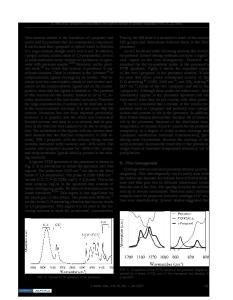Electrostatic Synthesis and Characterization of Pb(Zr x Ti 1-x )O 3 Micro/nano-fibers
- PDF / 907,985 Bytes
- 6 Pages / 612 x 792 pts (letter) Page_size
- 9 Downloads / 455 Views
Electrostatic Synthesis and Characterization of Pb(ZrxTi1-x)O3 Micro/nano-fibers Yu Wang, Santiago Serrano and Jorge J. Santiago-Aviles Department of Electrical Engineering, University of Pennsylvania, Philadelphia, PA 19104 ABSTRACT Pb(Zr0.48Ti0.52)O3 (PZT) micro/nano-fibers and mats were synthesized from alkoxides using electrostatic deposition. The PZT micro/nano-fibers precursor, a mixture of zirconium npropoxide, titanium isopropoxide, and lead 2-ethylhexanoate, was deposited under the following conditions: tip-screen distance=15cm, voltage drop between tip and screen of 15kV. The deposited fibers and mats samples were sintered for half an hour at 400, 500, 600, 700, and 800°C, respectively. Sintered mats were characterized using x-ray diffraction (XRD), sintered fibers were characterized using optical microscope, scanning electron microscopes (SEM), Raman microscope, and scanning probe microscope (SPM). SEM revealed that micro/nanofibers have diameters varying from a fraction of a micron to around 10 micrometer. XRD and Raman spectra indicated that the precursors begin to transform into intermediate phase Pb2Ti2O6 at 400°C, whose transformation into the perovskite phase starts at 600°C and ends at 800°C. Scanning probes microscope (SPM), operated in voltage-modulated dynamic contact mode, revealed the spontaneous polarization domains, with diameters ranging from 0.1 to 0.5 micron, in microfibers, confirming their piezoelectricity. INTRODUCTION Lead zirconate titanate, Pb(ZrxTi1-x)O3 (PZT) is widely known for their technological importance in the field of sensors, electronics and non-volatile ferroelectric memory devices[1]. Non-volatile ferroelectric memory requires that PZT be fabricated, polarized and depolarized in small-scale features. Fine-grained PZT not only meet such requirement, but also have other desired properties [2]. Lead zircon ate titanate can be synthesized in many different ways, including co-precipitation [3], sol-gel [4], hydrothermal reaction [5], reactive calcinations [6], ball milling [7] and others [8,9]. From that multiplicity of methods, the utilization of metal alkoxides as PZT precursors provides one of the most promising powder preparation methods in that it can reduce grain sizes of the PZT powder to submicrometer scale [10]. Although these methods have made great success in the preparation of PZT, some problems remain. For example, none of them can readily be utilized to fabricate PZT micro and nano-structures. Electrostatic generation, or electrospinning, of ultrafine fibers was invented in 1930s [11], and recently was used to produce conductive polymer fibers, carbon nanofibers [12]. The authors, having used it to produce polyacrylonitrile (PAN) and carbon nanofibers [13], speculated that it might also be used to synthesize fine-grained PZT microfibers. This article reports our efforts to electrostatically deposit PZT micro/nano-fibers and their characterization. EXPERIMENT The starting materials, zirconium n-propoxide, titanium isopropoxide, and lead 2ethylhexanoate were comme
Data Loading...










